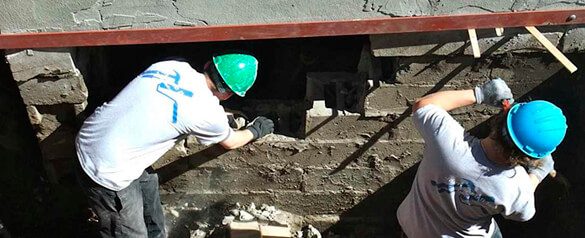Foundation Repair Prevention
Foundation repair is not something you want to do – it’s something you have to do. Homeowners fear foundation problems; however, few are aware of the simple steps they can take to eliminate the risk or minimize foundation movement. There are four areas that homeowners should be concerned about when it comes to avoiding the movement of slab foundations.
Plumbing
When leaks occur, large amounts of water can be discharged into the soil under the foundation. As the soil absorbs the water, it can swell, causing the upheaval of the foundation. The water supply to a home is metered and a review of your monthly bill will show the increase in water usage should a pressure line be leaking. No special precautions need to be taken to detect leaking pressure water lines. However, there is no immediate evidence when a sewer line fails.
Sewer lines can cause significant damage to foundations when leaks occur. PVC sewer lines can leak; however, fewer leaks occur because most are under 25 years old. Cast iron sewer lines have a life span of 25 to 35 years. Iron sewer lines tend to rust out. As holes increase in size, the more water they discharge under the foundation, causing noticeable sheetrock cracks in the walls and ceiling. Static pressure tests are a good way to identify leaking sewer lines. A reputable plumber can perform this test for approximately $250.
Water Your Foundation
Watering your foundation can help minimize foundation movement year-round. The secret is the proper amount of water at the proper time in order to keep the soils from shrinking in the summer months and over-expanding in the cooler, rainier months. Because foundations rest on top of many feet of soil, it can take an extreme amount of water to stabilize a home. A soaker hose placed about 12 inches out from the foundation or a drip irrigation system should be sufficient.
Since you can only see the surface of the ground, it can be difficult to determine the amount of water that is enough. A plumber’s probe works best in checking how deep the water has gone. Simply insert the probe into the soil; when you can push it in 2 to 4 feet, then there is probably enough water in the soil. If the probe slides into the ground with little pressure, then you probably need to cut back on the amount of time you are watering that area. Remember, not all areas around your home will need the same amount of water, so be sure to test all areas.
Drainage
Proper drainage is a must for all foundations. A good way to tell if you have proper drainage is to check 30 minutes after a good rain; if there is no water standing within 10 feet of the home, then the drainage is adequate. If water stands in pools or puddles against the sides of the foundation or paved areas, then a correction may be in order.
Root Barriers
Trees and shrubs are an important part of a beautiful Central Texas landscape, but their roots can cause damage to your foundation, sidewalks, and other landscaping.
To grow, a tree’s root system reaches out to seek sources of water – and many times, that source is located under your foundation. Once the roots reach the foundation, they soak up the moisture under the slab, causing the soil to dry out and your foundation to shift.
An effective root barrier system will prevent tree roots from ever reaching your home. The root barriers installed by Abacus consist of rigid panels that reach three feet down into the soil. California-sanctioned panels are eco-friendly so trees and other landscaping are not damaged, and save you money by helping to prevent the need for costly slab foundation repairs.
Landscaping
Landscaping can have a major impact on the performance of the foundation. The more plants you have, the more you have to water. Remember that different plant types can affect the foundation in different ways. Larger plants require more water and can affect foundations in different areas. Trees use about 150 gallons of water per day for every 12 inches of diameter (that’s over 20 cubic feet of water per day). Trees can have roots extending 1 1/2 times the height of the tree, extending far back under a foundation. As a result, this can cause the center or edge of a foundation to settle.
In order to minimize water consumption, trees should be at least 20 feet from the foundation. When mature trees have an effect on a foundation, Root Barriers are recommended. Root Barriers can be installed within 3 feet of the foundation and should be at least 3 feet deep in order to prevent or arrest interior foundation settlement. Shrubs that are next to a foundation should be kept at a maximum height of 3 feet and a distance of 2 feet from the foundation.
Landscaped beds can trap water against the sides of the foundation. When installing or maintaining landscaping, it is important to make sure there is adequate drainage.
Signs of Foundation Problems
Interior:
- Wall cracks
- Ceiling cracks
- Ceiling trim cracks or separation
- Doors that stick
- Windows that stick
- Fireplace cracks
- Fireplace separation from the wall
- Sunken or raised floor
- Cracks in floor tile
- Slope in the floor in the house or garage
- Cabinets that separate from wall or ceiling
- Paneling that separates the joints
- Wall separation from the floor
- Tears or wrinkles in wallpaper
Exterior:
- Broken or cracked bricks
- Broken or cracked mortar
- Chimney that tilts or is separated from the house
- Cracks in foundation
- Doors that stick
- Windows that stick
- Door frame that separates from brick or trim
- Patio or porch that separates from the house
- Uneven roof line
- Window frames that separate from brick or trim
- Window caulk separation
- Wood trim separation or movement
Hiring a Reliable Foundation Repair Contractor
With over 3,000 foundation repair contractors in the United States and 10% of them in Texas, how do you decide which method or contractor has the right answer for your home’s problems? The following is a short list of things to consider when interviewing and hiring a contractor:
Always
- Always obtain two or more bids.
- Always check with your local Better Business Bureau.
- Always check the contractor’s credentials along with the customer and professional references.
- Always check with the civil court system to verify that the contractor has no pending litigation by homeowners.
- Always consider video or audio taping the contractor’s salesperson to ensure you receive what is promised.
- Always consider hiring a professional engineer should your contractor not offer a truly independent registered professional engineer to sign off on the work completed.
Never
- Never sign a blank contract.
- Never sign a contract without reading and understanding all the clauses in it.
- Never submit to trickery or high-pressure tactics to get your signature on a contract.
- Never pay in full in advance, or in cash without obtaining a written receipt.

